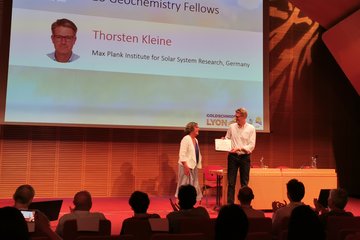Alle Typen
1.
Zeitschriftenartikel
Photometric Analysis of the Nucleus of the Main-belt Comet 2010 LH15. Research Notes of the American Astronomical Society 8, S. 104 (2024)
2.
Zeitschriftenartikel
Photometric Analysis of the Nucleus of the Main-belt Comet 2010 LH15. Research Notes of the American Astronomical Society 8, S. 104 (2024)
3.
Zeitschriftenartikel
Dynamics and potential origins of decimeter-sized particles around comet 67P/Churyumov-Gerasimenko. Astronomy and Astrophysics 685, S. A136 (2024)
4.
Zeitschriftenartikel
Distribution and dynamics of decimetre-sized dust agglomerates in the coma of 67P/Churyumov–Gerasimenko. Monthly Notices of the Royal Astronomical Society 519, S. 5775 - 5786 (2023)
5.
Zeitschriftenartikel
Probing the surface environment of large T-type asteroids. J. Astronomy and Astrophysics (2022)
6.
Zeitschriftenartikel
Sublimation origin of active asteroid P/2018 P3. Astronomy and Astrophysics 666, S. A163 (2022)
7.
Zeitschriftenartikel
VLT spectropolarimetry of comet 67P: dust environment around the end of its intense southern summer. Astronomy and Astrophysics 657, A40 (2022)
8.
Zeitschriftenartikel
On the trail of a comet's tail: A particle tracking algorithm for comet 67P/Churyumov-Gerasimenko. Astronomy and Astrophysics 659, S. A171 (2022)
9.
Zeitschriftenartikel
An update of the correlation between polarimetric and thermal properties of cometary dust. Astronomy and Astrophysics 650, L7 (2021)
10.
Zeitschriftenartikel
Transport Characteristics of the Near-Surface Layer of the Nucleus of Comet 67P/Churyumov–Gerasimenko. Solar System Research 55, S. 106 - 123 (2021)
11.
Zeitschriftenartikel
GAUSS - genesis of asteroids and evolution of the solar system: A sample return mission to Ceres. Experimental Astronomy (2021)
12.
Zeitschriftenartikel
Component properties and mutual orbit of binary main-belt comet 288P/(300163) 2006 VW139. Astronomy and Astrophysics 643, A152 (2020)
13.
Zeitschriftenartikel
The Nucleus of Interstellar Comet 2I/Borisov. The Astrophysical Journal Letters 888 (2), L23 (2020)
14.
Zeitschriftenartikel
Outburst and Splitting of Interstellar Comet 2I/Borisov. Astrophysical Journal, Letters 896 (2), L39 (2020)
15.
Zeitschriftenartikel
Coma Anisotropy and the Rotation Pole of Interstellar Comet 2I/Borisov. Astrophysical Journal, Letters 895 (2), L34 (2020)
16.
Zeitschriftenartikel
Hubble Space Telescope Search for Activity in High-perihelion Objects. Astronomical Journal 159 (5), 209 (2020)
17.
Zeitschriftenartikel
Thermophysical model for icy cometary dust particles. Astronomy and Astrophysics 643, A16 (2020)
18.
Zeitschriftenartikel
Cometary Comae-Surface Links: The Physics of Gas and Dust from the Surface to a Spacecraft. Space Science Reviews 216 (8), 130 (2020)
19.
Zeitschriftenartikel
Recurrent Cometary Activity in Near-Earth Object (3552) Don Quixote. The Planetary Science Journal 1 (1), 12 (2020)
20.
Zeitschriftenartikel
Tomographic inversion of gravity gradient field for a synthetic Itokawa model. Icarus 336, 113425 (2020)











